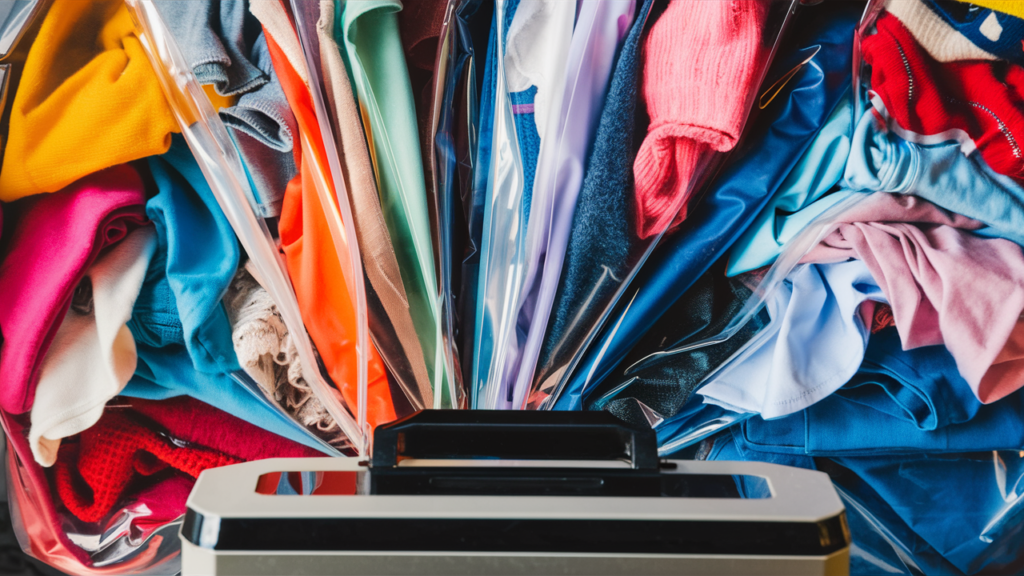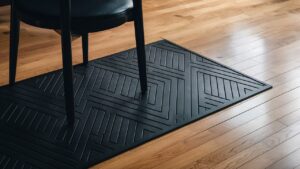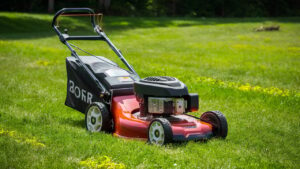To use a vacuum bag for clothes, simply pack your folded clothing into the bag, making sure not to overstuff it. Only fill the bag to the printed “fill line” located near the top/zipper.
Recommended Best Vacuum Seal Bags 2025-2026
| Recommendation | Product |
| Best Overall | 20 Pack Vacuum Storage Bag by Cozy Essential |
| Popular Choice | HIBAG Vacuum Storage Bags |
| Best Value | 24 Pack Vacuum Storage Bags with Electric Pump |
| Best Budget | SUOCO 8 Jumbo Vacuum Storage Bags |
| Another Excellent Pick | 16 Pack Vacuum Storage Bags with Hand Pump |
Then, slide the zipper across the top of the bag to close it. Vacuum bags are a great way to save space and keep your clothes organized, especially for travel or storing off-season clothing. However, it’s important to note that not all types of clothing are suitable for vacuum sealing, such as leather, silk, cashmere, and thick wool garments.
In this blog, we’ll explore the benefits of using vacuum bags for clothes, what types of clothes to avoid sealing, and how to properly use and store your vacuum-sealed bags.

Choosing The Right Vacuum Bag
When it comes to storing clothes, vacuum bags are a game-changer. They help maximize storage space by compressing your clothing, making it easier to organize and store. However, choosing the right vacuum bag is crucial to ensure the safety and longevity of your clothes. In this section, we will discuss how to identify the correct size and explore the different types of vacuum bags available for clothing.
Identifying The Correct Size
Before purchasing vacuum bags, it’s important to identify the correct size for your clothing. Using bags that are too small can damage your clothes, while bags that are too big may not provide the desired compression. Here are a few steps to help you identify the correct size:
- Sort your clothing by category (e.g., shirts, pants, sweaters).
- Count the number of items in each category.
- Estimate the total volume of each category by folding one representative item and measuring its dimensions.
- Choose a vacuum bag size that can accommodate the total volume of each category, allowing some room for compression.
By following these steps, you can ensure that your clothes fit comfortably in the vacuum bags without being overstuffed or too loose.
Types Of Vacuum Bags For Clothing
There are various types of vacuum bags available for storing clothes. Here are a few common options:
| Type | Description |
|---|---|
| Standard Vacuum Bags | These bags are made of durable plastic and can be sealed using a regular vacuum cleaner. They are suitable for most types of clothing and provide excellent compression. |
| Travel Vacuum Bags | Designed specifically for travel, these bags are more compact and portable. They usually come with a manual pump for compressing the bags without the need for a vacuum cleaner. |
| Hanging Vacuum Bags | These bags are equipped with a hanger, making them ideal for storing garments that need to be hung, such as dresses, suits, and coats. They provide the convenience of easy access while still offering compression. |
When choosing the type of vacuum bag, consider your specific storage needs and preferences. Each type has its advantages and is suitable for different clothing items.
By understanding how to identify the correct size and exploring the different types of vacuum bags available, you can make an informed decision and choose the right vacuum bag for your clothes. This ensures efficient storage, protection, and easy retrieval of your clothing whenever needed.
Preparation Before Packing
To use vacuum bags for clothes, simply place your folded clothing into the bag, making sure not to overstuff it. Fill the bag only to the printed “fill line” near the top, then close it by sliding the zipper across.
Vacuum-seal bags are great for storing off-season clothes and blankets, reducing their size for easy storage.
Sorting Clothes By Material
Before using a vacuum bag for clothes, it’s crucial to sort your garments by material. Separate your clothes into categories such as cotton, denim, wool, and synthetic fabrics. This will help prevent any potential damage that could occur when storing different materials together.
Cleaning Garments
Prior to packing your clothes in a vacuum bag, ensure that all garments are clean and free from any stains or odors. It’s important to wash and dry your clothes thoroughly before storing them to prevent any potential mildew or musty smells from developing over time.
Folding Techniques For Optimal Space
When preparing to pack your clothes in a vacuum bag, employ strategic folding techniques to maximize space. Utilize methods such as the KonMari fold or rolling garments to minimize wrinkles and create more room in the bag. Additionally, consider placing heavier items at the bottom and lighter items on top to prevent creasing.
Filling The Vacuum Bag
When it comes to filling a vacuum bag, there are a few key strategies to keep in mind to ensure that your clothes are properly stored and protected. Whether you’re prepping for a move, maximizing closet space, or organizing seasonal items, the way you fill your vacuum bag can make all the difference in terms of space and preservation.
Layering Strategy
Proper layering of clothes in a vacuum bag can help maximize space and prevent wrinkles. Start by placing heavier items, such as jeans and sweaters, at the bottom of the bag. Then, layer lighter and delicate items, like t-shirts and dresses, on top to create a balanced and compact arrangement.
Avoiding Overstuffing
Avoid overstuffing the vacuum bag, as it can lead to an inefficient seal and may cause damage to the zipper. Be mindful of the bag’s capacity and only fill it with the amount of clothing that comfortably fits without excessive force.
Respecting The Fill Line
Respect the fill line indicated on the vacuum bag. Overfilling can compromise the effectiveness of the vacuum seal and hinder the bag’s ability to compress the clothing properly. Adhering to the fill line ensures that the bag functions optimally and protects your clothes during storage.
Sealing The Vacuum Bag
When using a vacuum bag for clothes, make sure to pack your folded garments into the bag without overstuffing it. Fill the bag only up to the designated “fill line” and then close it by sliding the zipper across the top.
This effective method helps save space and keeps your clothes protected.
Steps For Proper Closure
To ensure an airtight seal when using vacuum bags for clothes, follow these simple steps:
- Begin by folding your clothing neatly and placing them inside the bag. Avoid overstuffing the bag as this can prevent proper sealing.
- Make sure to only fill the bag up to the designated “fill line” located near the top or zipper of the bag. This will ensure that there is enough space for the vacuum to remove the air efficiently.
- Once your clothes are inside and the bag is properly filled, it’s time to seal it shut. Gently slide the zipper across the top of the bag, making sure it is securely closed.
- Double-check the zipper to ensure that it is fully closed from end to end. Any gaps or openings can compromise the airtight seal.
- If you want to be extra cautious, you can use your hands to press along the zipper line to ensure it is tightly sealed.
By following these steps, you can be confident that your vacuum bag is properly sealed and ready to be compressed. This will not only save you valuable storage space but also protect your clothes from dust, moisture, and pests.
Extracting The Air
To use vacuum bags for clothes, start by packing your folded clothing into the bag and make sure not to overstuff it. Only fill the bag to the printed “fill line” located near the top/zipper. Then, slide the zipper across the top of the bag to close it.
Vacuum-seal the bag to extract the air and store it in a dry place. Vacuum bags are great for storing off-season clothes and blankets too.
Extracting the Air
Once you have packed your clothes into the vacuum bag, it’s time to extract the air to compress the bag. There are two ways to do this: using a vacuum cleaner or manual air extraction methods.
Using a Vacuum Cleaner
Using a vacuum cleaner is the easiest and most efficient way to extract air from the vacuum bag. First, locate the vacuum port on the bag. It is usually located near the bottom of the bag. Next, attach the hose of your vacuum cleaner to the port. Turn on the vacuum cleaner and allow it to suck the air out of the bag. As the air is extracted, you will notice the bag compressing and your clothes becoming more compact.
Manual Air Extraction Methods
Manual air extraction methods are an alternative to using a vacuum cleaner. These methods are useful when you don’t have access to a vacuum cleaner or need to save space when packing. There are three main manual air extraction methods: rolling, pressing, and sitting.
Rolling involves rolling the vacuum bag from the bottom up to the top, pushing the air out as you go. Pressing involves pressing down on the bag to force the air out. Sitting involves sitting on the bag to compress it and force the air out.
No matter which manual air extraction method you choose, be sure to press out as much air as possible to compress the bag and maximize space. Once all the air is extracted, seal the bag tightly to prevent air from getting back in.
In conclusion, whether you choose to use a vacuum cleaner or manual air extraction methods, extracting the air from your vacuum bag is a crucial step to compress your clothes and maximize space.
Storing Vacuum-sealed Bags
To store clothes in vacuum-sealed bags, first fold them neatly and place them inside the bag, making sure not to overstuff it. Only fill the bag up to the printed “fill line” located near the top/zipper. Then, slide the zipper across the top of the bag to close it.
Vacuum out the air using a vacuum cleaner or pump, and finally, store the bags in a cool, dry place. Vacuum-sealed bags are a great way to store off-season clothes and blankets, but avoid vacuum sealing leather, silk, cashmere, thick wool garments, or any natural fiber materials that could be damaged by compression.
Choosing The Right Environment
When it comes to storing vacuum-sealed bags, it is important to choose the right environment. You will want to store your bags in a cool, dry place, away from direct sunlight. This will help to prevent any damage to your clothes and keep them fresh for longer. It is also a good idea to avoid storing your bags in areas with high humidity, such as basements or attics.
Positioning Bags For Easy Access
Another important factor to consider when storing vacuum-sealed bags is positioning them for easy access. You will want to make sure that you can easily find and access the bags when you need them. One way to do this is to stack the bags in a labeled container or on a shelf. You can also hang the bags using a hanger or hook, making them easily accessible in your closet or storage space.
Keeping Bags Secure
When storing vacuum-sealed bags, it is important to ensure that each bag is secure. This will help to prevent any air from getting in and causing damage to your clothes. You can do this by making sure that the bags are properly sealed and that there are no holes or tears in the bag. It is also a good idea to store the bags upright, as this will help to prevent any damage to the clothes inside.
In conclusion, storing vacuum-sealed bags is an effective way to save space and keep your clothes fresh. By choosing the right environment, positioning the bags for easy access, and keeping them secure, you can ensure that your clothes remain in good condition for longer.
Materials To Avoid Vacuum Sealing
When it comes to using vacuum bags for clothes, it’s important to know which materials should be avoided. While vacuum-sealing can be a great way to save space and protect your clothing, there are certain fabrics and items that are not suitable for this method. Here are two categories of materials that should be kept away from vacuum sealing:
Sensitive Fabrics And Materials
Some fabrics and materials are more delicate and can be easily damaged when subjected to the compression and suction of a vacuum bag. It’s essential to avoid vacuum sealing items made from sensitive fabrics such as:
- Silk
- Cashmere
- Leather
- Thick wool garments
These materials can lose their shape, become wrinkled, or even get permanently damaged when compressed in a vacuum bag. It’s best to store them using alternative methods to ensure their longevity.
Items Prone To Damage From Compression
Aside from sensitive fabrics, there are other items that are not suitable for vacuum sealing due to their vulnerability to damage from compression. These may include:
- Items with feathers
- Woven items
- Hemp clothing
Feathers can get flattened and lose their fluffiness when vacuum sealed, while woven and hemp items may lose their texture and shape. It’s important to consider these factors and opt for alternative storage solutions for such items.
By avoiding vacuum sealing these materials, you can ensure the longevity and quality of your clothing and other belongings. Instead, consider using alternative storage methods like garment bags or hanging storage for delicate fabrics, and fold and store items prone to damage in a regular storage container.
Opening And Reusing Vacuum Bags
Once you’ve successfully vacuum-sealed your clothes for storage, you may need to open and reuse the bags at a later time. Here are some essential tips for opening and reusing vacuum bags:
Careful Opening To Prevent Damage
When opening a vacuum bag, it’s crucial to do so carefully to avoid damaging the bag or its contents. Start by locating the zipper seal and gently pull it apart to release the airtight seal. Avoid using sharp objects that could puncture the bag, and be cautious not to tear the plastic when separating the seal.
Maintaining Vacuum Bags For Future Use
After opening a vacuum bag, it’s important to maintain its condition for future use. Inspect the bag for any signs of damage, such as tears or weakened areas. If the bag is in good condition, it can be reused for storing clothes or other items by following the proper vacuum-sealing process again.
Travel Tips With Vacuum Bags
Discover the ultimate travel tips with vacuum bags and learn how to use them for clothes. Pack your folded clothing into the bag, making sure not to overstuff it. Fill the bag only up to the designated “fill line” and then close it by sliding the zipper across the top.
Enjoy the benefits of efficient storage and wrinkle-free clothes while on the go.
Packing For Trips
Vacuum Packing Without A Vacuum Cleaner
Troubleshooting Common Issues
Learn how to troubleshoot common issues when using vacuum bags for clothes. Follow the instructions to pack your clothes carefully, ensuring not to overstuff the bag and only fill it to the designated “fill line. ” Then, seal the bag by sliding the zipper across the top.
Dealing With Leaks
If you are experiencing leaks with your vacuum bag for clothes, there are a few troubleshooting steps you can take to resolve the issue. Firstly, check if the bag is properly sealed. Make sure the zipper is completely closed and that there are no gaps or openings. If you find any, try resealing the bag, making sure there is a tight seal.
If the bag still leaks after resealing, inspect it for any tears or holes. Sometimes, small punctures can occur during the packing process. If you find any, you can try patching them up using a piece of clear tape or a vacuum bag repair kit. Remember to apply the patch on both sides of the bag for maximum effectiveness.
Another common cause of leaks is overfilling the bag. If you have stuffed the bag beyond its capacity, the excess pressure can cause the bag to burst or leak. To avoid this issue, always make sure to follow the fill line printed on the bag. Only fill the bag up to that line to ensure proper sealing and compression.
Ensuring Long-term Compression
To ensure long-term compression with your vacuum bag for clothes, there are a few tips you can follow. Firstly, it is important to choose a high-quality vacuum bag that is specifically designed for long-term storage. These bags are usually made of durable materials that can withstand the pressure of compression for extended periods.
When packing your clothes, make sure to fold them neatly and avoid any wrinkles or creases. This will not only maximize the space in the bag but also prevent any damage to the fabric. Avoid overpacking the bag as it can reduce the effectiveness of the vacuum sealing process and compromise the compression.
It is also recommended to store the vacuum bag in a cool, dry place away from direct sunlight. Exposure to heat and moisture can weaken the bag’s seal and reduce its compression capabilities over time. Additionally, avoid placing any sharp or heavy objects on top of the bag to prevent any potential damage.
By following these tips and troubleshooting common issues, you can make the most out of your vacuum bag for clothes and ensure optimal compression and storage for your garments.
Frequently Asked Questions
What Is The Best Way To Put Clothes In A Vacuum Bag?
To put clothes in a vacuum bag, fold your clothing and place it inside the bag, making sure not to overstuff it. Fill the bag only up to the indicated “fill line” and then close it by sliding the zipper across the top.
Vacuum bags are great for storing off-season clothes and blankets. Avoid vacuum sealing leather, silk, cashmere, thick wool, or any natural fiber materials that could be damaged by compression.
How To Use Vacuum Bags Effectively?
To use vacuum bags effectively, pack your folded clothes into the bag without overstuffing it. Fill only up to the printed “fill line” and then zip it closed. Vacuum out the air using a vacuum cleaner hose and seal the valve.
Store the compact bag in a cool, dry place.
Do Vacuum Bags Work For Clothes?
Yes, vacuum bags work great for storing clothes by removing air and reducing bulk for efficient storage.
What Clothes Should You Not Vacuum Seal?
Certain types of clothes should not be vacuum sealed, such as leather, silk, cashmere, thick wool garments, and any natural fiber materials that could be damaged by compression. This includes woven items, hemp, and items with feathers. It is best to avoid vacuum sealing these delicate or sensitive fabrics to preserve their quality.
Conclusion
Using vacuum bags for clothes can be a game-changer when it comes to maximizing storage space and keeping your garments fresh and organized. By following the proper steps of packing your clothes, ensuring not to overstuff the bag, and sealing it correctly, you can effectively utilize vacuum bags for storing off-season clothing and bulky items.
Remember to avoid vacuum sealing delicate materials such as leather, silk, cashmere, and thick wool to prevent damage. With the right approach, vacuum bags can be a valuable tool in decluttering and optimizing your storage solutions.








